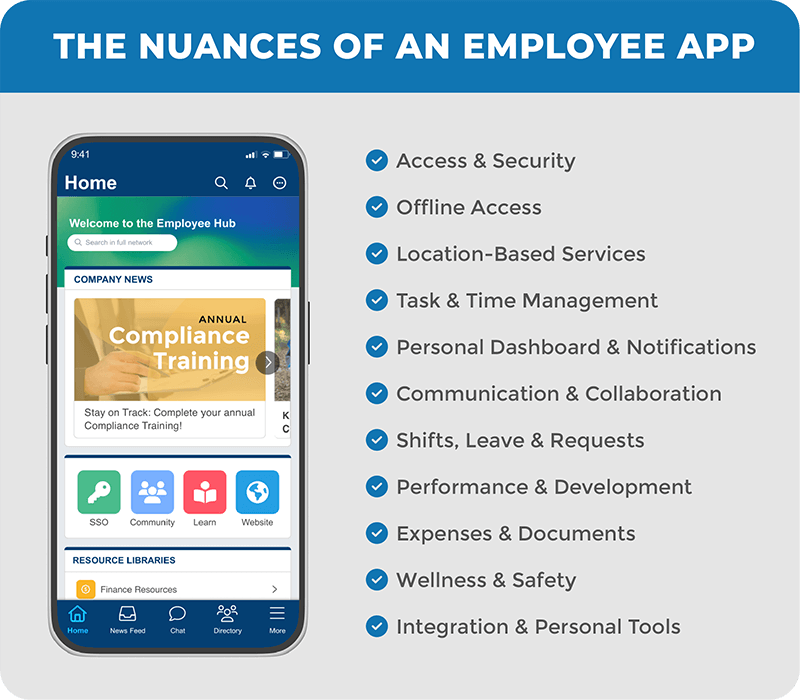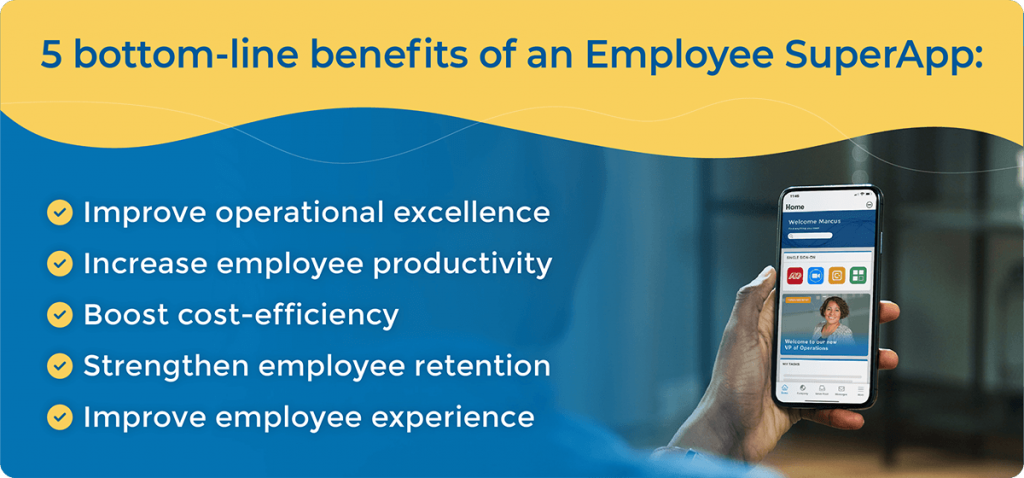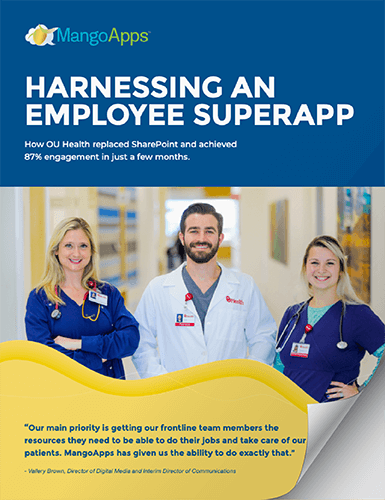This is Part 3 in our series about the differences between an intranet and employee app.
In the previous segment of this series, we delved deep into the shared characteristics of intranets and employee apps. While they may come together in harmony, offering a robust set of tools to facilitate communication and collaboration in the corporate space, they each shine their brightest in different areas, displaying nuances that make them distinct and particularly suited to various aspects of organizational functionality. In this segment we will look at the nuances that differentiate an intranet from an employee app. So, if you are using an intranet and considering employee app adoption, and don’t understand the differences – this article is for you.
The Differences of an Intranet

Intranets serve as a backbone in many organizations, facilitating collaborative workspaces and acting as repositories for a wealth of company information. They are designed with a focus on communal and departmental interactions rather than individual engagements, providing a structured platform where employees can share knowledge, engage in rich discussions, and access an array of resources to enhance collaborative efforts within the company. Let’s explore the intricate nuances that set intranets apart in the corporate ecosystem.
Collaborative Space
Intranets are designed primarily as collaborative spaces, places where teams across a company can connect, share documents, and work together seamlessly on various projects. This collaborative nature extends beyond the physical workspace; it is a virtual meeting ground where ideas are exchanged and nurtured to fruition. Employee apps, on the other hand, tend to focus more on individual productivity, offering features tailored to personal task management rather than a collaborative workspace. Therefore, while intranets foster a collaborative spirit by providing tools and platforms for group discussions and brainstorming, employee apps prioritize personal productivity tools that aid individual employees in managing their tasks effectively.
Content Repository
When it comes to housing a wide range of company documents, from policies to training materials, intranets serve as central repositories where such data is stored and can be accessed over years. This large library is vital in maintaining a rich history of the organization’s intellectual property, allowing for continuity and reference over time. Employee apps generally focus more on current tasks and individual functionalities, offering less in the way of a historical repository of organizational knowledge. While they may provide access to necessary documents, they rarely house the extensive library of resources often found in an intranet.
Departmental Sections
Intranets frequently feature dedicated sections or portals for different departments, each with its own set of resources, news, and tools. This allows for a sort of microcosm within the larger organization where individual departments can manage their specific needs while still staying connected to the broader organizational ecosystem. Employee apps, conversely, are more about individual personalization, offering features that cater to the needs and preferences of individual employees rather than focusing on departmental delineations.
Discussion Forums
Discussion forums are a significant part of many intranets, fostering a space where employees can discuss a wide variety of topics, share knowledge, and seek advice. These forums encourage open communication and the free exchange of ideas, promoting a collaborative and inclusive work culture. In contrast, employee apps generally lean more towards facilitating direct, peer-to-peer interactions through chat features, offering a quicker, more immediate form of communication but potentially lacking the depth and breadth of discussion found in intranet forums.
Company-Wide Announcements
Intranets are typically the go-to platform for company-wide announcements, newsletters, and updates. They act as the central hub for corporate communications, ensuring that all employees are kept informed about the latest developments and news in the organization. Employee apps, while also offering communication features, tend to focus more on personalized notifications and alerts, delivering information directly relevant to individual employees rather than broad company-wide announcements.
Advanced Search
Given the vast amount of content available on intranets, advanced search functionalities are often incorporated, including features such as filters, tags, and categories to aid in the quick retrieval of information. This functionality is essential in helping employees navigate the extensive resources available efficiently. Employee apps, with their more narrow focus on individual tasks and functions, often do not require such advanced search capabilities, as the scope of information available is generally more limited and personalized to the user’s role and functions.
Integration with Enterprise Systems
Intranets often boast substantial integrative capabilities, serving as a hub that connects various platforms such as HR systems, CRMs, and ERPs into a cohesive whole. This integration enables streamlined operations and a centralized point of access to a wide variety of tools and resources. While employee apps also offer integrative features, the focus is generally more on integrating with personal productivity tools to facilitate a seamless work-life blend, rather than focusing on broader enterprise system integrations.
Long-Term Archiving
The role of intranets as archives for long-term storage of company knowledge and historical data cannot be understated. This feature ensures that vital company knowledge is preserved over time, available for future reference and helping to maintain a continuous organizational narrative. Employee apps, on the other hand, are generally more focused on the here and now, offering features that facilitate current tasks and needs rather than preserving historical data for the long term.
Training Platforms
Intranets more and more have integrated Learning Management Systems where employees can undertake training modules, engage with instructional videos, and complete assessments to further their professional development. This central hub for learning facilitates continuous employee growth and development. Employee apps, while they may offer reminders and notifications for training and development opportunities, generally do not house the rich array of learning resources and modules typically found on an intranet platform.
Feedback and Polling
Intranets are also equipped with tools for gathering company-wide feedback and conducting polls or facilitating suggestion schemes, which foster a democratic and inclusive work environment. They create avenues for employees to voice their opinions and feedback on various organizational aspects. Employee apps, though they may offer quick polls or feedback tools, usually focus on a more immediate and narrow scope, capturing feedback quickly but perhaps not with the same depth and detail as intranet-based feedback tools.
The Differences of an Employee App

When we talk about the finer points of employee apps, it is essential to highlight how they stand apart from traditional intranets. Below, we explore the intricate details that define employee apps, emphasizing their modern approach to enhancing workforce efficiency and engagement.
Access & Security
Employee apps are designed to give secure and efficient access to all work-related resources right through personal and mobile devices, setting a departure from the broader and less personalized scope of intranets. This individual-centered approach extends to features such as biometric authentication, ensuring security and offering a tailored experience to each user. Employees can navigate a wealth of resources and tools designed for their roles and preferences, an initiative towards a personalized, secure work environment.
Offline Access
Unlike traditional intranets, employee apps excel in providing functionalities even in offline scenarios, a standout feature that ensures uninterrupted workflow. The workers can utilize the fundamental features sans an internet connection, a boon in areas grappling with connectivity issues. This reliability fosters a work dynamic that remains consistent and productive, no matter the circumstances.
Geo-Fencing & Location-Based Services
Employee apps have brought innovation with geo-fencing and location-based services, an enhancement barely mirrored in an intranet. It allows organizations to offer a customized app experience based on the geographic location of the employee, either enabling or restricting functionalities accordingly. This goes a long way in not just securing data but also in crafting experiences that fit the working conditions, be it remote or on-site, of every individual, enhancing both security and personalization.
Task & Time Management
The task and time management features in employee apps offer a detailed and microscopic view of one’s schedule, a sharp contrast to the generalized overviews found in intranets. Employees can take charge of their schedules with detailed control, setting reminders and tracking personal deadlines to foster personal productivity. This intricate management facilitates effective handling of work commitments, moving a step further in individual-centric functionalities.
Personal Dashboard & Notifications
The personal dashboard stands as the nerve center of an employee app, showcasing real-time alerts and vital information pertinent to individual employees. This space goes beyond the generic updates seen in intranets, offering an intuitive and engaging user experience. It aids employees in keeping a close eye on their work schedules and updates, enhancing efficiency and productivity through a personalized touch.

Communication & Collaboration
Employee apps promote a culture of openness and direct engagement, a facet less explored by intranets. They serve as a potent platform for spontaneous, peer-to-peer interactions, enabled effortlessly on mobile devices. This enhancement leads to a more connected, collaborative, and responsive work environment, fostering a culture of direct communication and rapid responses.
Shifts, Leave & Requests
Centralizing the management of shifts, leave, and requests, employee apps have streamlined what was once a cumbersome process in many intranets. Real-time notifications play a pivotal role here, allowing employees to manage their schedules fluidly and transparently. It removes the hassle typically involved in scheduling processes, encouraging a smoother operational flow and higher levels of satisfaction among employees.
Performance & Development
Employee apps take a personalized route to nurture individual growth paths, going beyond the broad strokes often seen in intranet systems. These apps offer insights into personal performance metrics and timely reminders for training sessions, a focused approach to foster continuous learning and development. This approach ensures that individuals have a clear roadmap to their growth within the organization, encouraging an environment of active development.
Expenses & Documents
Handling administrative tasks becomes a straightforward affair with employee apps, which stand in contrast to the sometimes convoluted processes seen in intranets. The on-the-go expense tracking and easy access to essential documents match the fast pace of the modern workforce. It not only saves time but significantly reduces the effort traditionally associated with managing administrative tasks, bringing in a breeze of convenience and efficiency.
Wellness & Safety
Employee apps prioritize the wellness and safety of the workforce, integrating tools and features that are generally not the focal point in intranet systems. Through wellness reminders and emergency alerts, these apps foster a nurturing and caring work environment. This approach ensures that the work culture remains infused with a sense of safety and well-being, promoting a balanced work-life scenario and enhanced job satisfaction.
Integration & Personal Tools
A defining nuance of employee apps is their seamless integration with personal productivity tools, an aspect not commonly supported by intranets. This integration creates a harmonious blend of work and personal life, fostering an environment where both can coexist without friction. It stands as a testimony to the modern, integrated approach to work-life dynamics, actively promoting both productivity and well-being.
We’ve covered a lot of ground discussing the distinct features and differences of both intranets and employee apps. While intranets often act as a centralized hub for collaboration and corporate knowledge, employee apps prioritize individual experiences, offering personalized tools and resources.

Part 4: Intranet vs. Employee App: Bridging Understanding with Simple Analogies
Next up, we will break this down even further, using straightforward analogies to highlight the differences between the two. Stay tuned to gain a clearer, simpler understanding of how these platforms operate and what they can offer to an organization.
Get the best of both worlds with MangoApps Employee SuperApp! Not ready for that transformation? Start with either a MangoApps Modern Intranet or MangoApps Employee App and we’ll help you transform to a SuperApp when you are ready.








